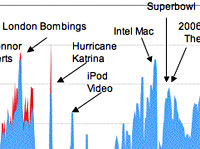 In February, we reported how blogs were replicating like Tribbles on heat, but the latest set of figures from Technorati suggest that someone must have added Viagra to their water, as a new weblog is spawned every single second of every day.
In February, we reported how blogs were replicating like Tribbles on heat, but the latest set of figures from Technorati suggest that someone must have added Viagra to their water, as a new weblog is spawned every single second of every day.
The blogosphere is now over 60 times bigger than it was just 3 years ago, with the total number of blogs doubling every 6 months.
Bloggers are sticking with it too, with the figures revealing that 9.4 million bloggers (55%) are still posting 3 months after first creating their blogs.
This represents an increase in both absolute and relative terms from three months ago when only 50.5% (or 13.7 million blogs) were active.
 Blogging has now become such a significant part of some
Blogging has now become such a significant part of some sad people’s interesting folk’s lives, that around 3.9 million bloggers faithfully update their blogs at least weekly – a figure that includes both Simon and Mike at Digital-Lifestyles.
Spammers, Splogs, Spings and Pains in the Sparse
Naturally, spammers and scammers have been quick to embrace the blog revolution, setting up spam blogs (Splogs) and Splings (‘ping spam’ used to made to make the content seem fresh).
 Pesky blog spammers have been generating an increasing level of noise with their nefarious activities throughout 2006, but the level of genuine, original content still greatly outweighs the fake and/or regurgitated content churned out on splogs.
Pesky blog spammers have been generating an increasing level of noise with their nefarious activities throughout 2006, but the level of genuine, original content still greatly outweighs the fake and/or regurgitated content churned out on splogs.
Blogging crazy
Technorati reports that there are now over 1.2 Million legitimate posts per day – about 50,000 posts per hour – with major news events being reflected in increased spikes in traffic.
Along with rushes in traffic for tragic events like the London Bombings and Hurricane Katrina, Technorati’s report also revealed large bursts of blogging activity for the Live 8 concerts, the Intel Mac announcement and the iPod video launch.
And Cardiff City scores. Possibly.